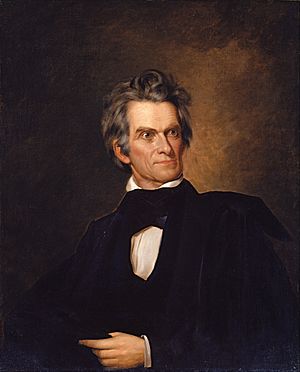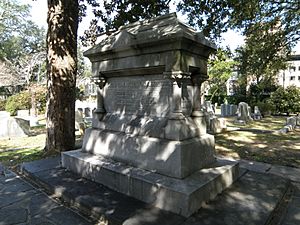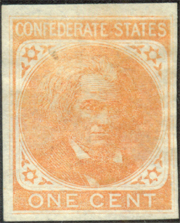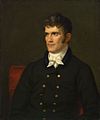John C. Calhoun facts for kids
Quick facts for kids
John C. Calhoun
|
|
|---|---|

Portrait c. 1845
|
|
| 7th Vice President of the United States | |
| In office March 4, 1825 – December 28, 1832 |
|
| President |
|
| Preceded by | Daniel D. Tompkins |
| Succeeded by | Martin Van Buren |
| United States Senator from South Carolina |
|
| In office November 26, 1845 – March 31, 1850 |
|
| Preceded by | Daniel Elliott Huger |
| Succeeded by | Franklin H. Elmore |
| In office December 29, 1832 – March 3, 1843 |
|
| Preceded by | Robert Y. Hayne |
| Succeeded by | Daniel Elliott Huger |
| 16th United States Secretary of State | |
| In office April 1, 1844 – March 10, 1845 |
|
| President | John Tyler James K. Polk |
| Preceded by | Abel P. Upshur |
| Succeeded by | James Buchanan |
| 10th United States Secretary of War | |
| In office December 8, 1817 – March 4, 1825 |
|
| President | James Monroe |
| Preceded by | George Graham (acting) William H. Crawford |
| Succeeded by | James Barbour |
| Member of the U.S. House of Representatives from South Carolina's 6th district |
|
| In office March 4, 1811 – November 3, 1817 |
|
| Preceded by | Joseph Calhoun |
| Succeeded by | Eldred Simkins |
| Personal details | |
| Born |
John Caldwell Calhoun
March 18, 1782 Abbeville, South Carolina, U.S. |
| Died | March 31, 1850 (aged 68) Washington, D.C., U.S. |
| Resting place | St. Philip's Church |
| Political party | Democratic-Republican (before 1828) Democratic (1828, 1839–1850) Nullifier (1828–1839) |
| Spouse |
Floride Bonneau Calhoun
(m. 1811) |
| Children | 10, including Anna Maria Calhoun Clemson |
| Parents | Patrick Calhoun Martha Caldwell |
| Education | Yale College Litchfield Law School |
| Signature | |
John Caldwell Calhoun (March 18, 1782 – March 31, 1850) was the Vice President of the United States for John Quincy Adams and Andrew Jackson. Calhoun was Vice President under two different presidents. He is one out of two Vice Presidents (along with George Clinton) who did this. Calhoun was the first vice president in U.S. history to resign from office, doing so on December 28, 1832.
Early life
John Calhoun was the son of Scots-Irish immigrant Patrick Calhoun.
Young Calhoun studied briefly in an academy in Appling, Georgia. When it closed, he continued his studies privately. When his father died, the 14-year-old Calhoun took over management of the family farm and five other farms. For four years he kept up his reading and his hunting and fishing. With financing from his brothers, he went to Yale College in Connecticut in 1802.
Calhoun made friends easily, read widely, and was a noted member of the debating society of Brothers in Unity. He graduated as valedictorian in 1804. He studied law at the nation's first independent law school, Tapping Reeve Law School in Litchfield, Connecticut. He was admitted to the South Carolina bar in 1807.
Career
Calhoun began his political career with election to the House of Representatives in 1810. He strongly supported the War of 1812. After the war, he proposed a Bonus Bill for public works.
In 1817, President James Monroe appointed Calhoun to be Secretary of War. In that position, he reorganized and modernized the War Department.
He was a candidate for the presidency in the 1824 election. However, as no candidate received a majority in the Electoral College, the election was ultimately resolved by the House of Representatives. Calhoun forged an alliance between factions that made John Quincy Adams President and Calhoun Vice President. However, Calhoun would soon break with Adams because he believed Adams unfairly favored Northern interests.
Calhoun also opposed President Adams' plan to send a delegation to observe a meeting of South and Central American leaders in Panama, believing that the United States should stay out of foreign affairs. Calhoun became disillusioned with Adams' high tariff policies and increased centralization of government, which he saw as a threat to the rights of the states.
He was Andrew Jackson's running mate in the election of 1828, and again became Vice President, which makes Calhoun the most recent U.S. vice president to serve under two different presidents.
He had a difficult relationship with Jackson, primarily because of the Nullification Crisis. Nullification is a legal theory that a state has the right to nullify, or invalidate, any federal law it deems unconstitutional. President Jackson generally supported states' rights, but opposed nullification and secession.
In October 1832, the South Carolina legislature voted to call a convention to nullify a revision to tariff rates supported by Jackson known as the Tariff of 1832. On November 24, both the Tariff of 1832 and the Tariff of 1828 ere nullified by the South Carolina Nullification Convention. The state threatened to secede if the federal government attempted to enforce the tariffs. In response, Jackson sent U.S. Navy warships to Charleston harbor, and threatened to hang Calhoun or any man who worked to support nullification or secession. As tensions over nullification escalated, Calhoun resigned as vice president and entered the Senate.
He sought the Democratic Party nomination for the presidency in 1844 but lost to surprise nominee James K. Polk, who won the general election.
Calhoun served as Secretary of State under President John Tyler from 1844 to 1845, and in that role supported the annexation of Texas as a means to extend the Slave Power and helped to settle the Oregon boundary dispute with Britain. Calhoun returned to the Senate, where he opposed the Mexican–American War, the Wilmot Proviso and the Compromise of 1850 before he died of tuberculosis in 1850.
Later in life, Calhoun became known as the "cast-iron man" for his rigid defense of white Southern beliefs and practices. He was a pro-slavery advocate and owned dozens of slaves in Fort Hill, South Carolina. Calhoun asserted that slavery was a "positive good" that benefited both slaves and enslavers.
To protect minority rights against majority rule, he called for a concurrent majority by which the minority could block some proposals that it felt infringed on their liberties.
Death and posthumous legacy
Calhoun died on March 31, 1850, of tuberculosis in Washington, DC, at the age of 68. He was buried in St. Phillips Churchyard in Charleston, South Carolina.
Calhoun received many honors after his death. However, he is considered a highly controversial figure because of his views on slavery.
During the Civil War, the Confederate government honored Calhoun on a one-cent postage stamp, which was printed but never officially released.
Calhoun was also honored by his alma mater, Yale University, which named one of its undergraduate residence halls "Calhoun College." (In recent years some students have called for the residence hall to be renamed, either by dropping the name of the slavery defender entirely or by hyphenating Calhoun's name with the name of a civil rights leader. Their efforts have not been successful, but the issue flares periodically.) The university also erected a statue of Calhoun in Harkness Tower, a prominent campus landmark.
Clemson University is also part of Calhoun's legacy. The campus sits on Calhoun's Fort Hill plantation, which he bequeathed to his son-in-law, Thomas Green Clemson.
Calhoun is also the namesake for Calhoun Community College in Decatur, Alabama.
In 1957, United States Senators honored Calhoun as one of the "five greatest senators of all time." A 2000 Senate resolution named him one of the "seven greatest" of all time.
Personal life
On January 8, 1811, he married Floride Bonneau Colhoun. The couple had ten children over an 18-year period:
- Andrew Pickens (1811–1865)
- Floride Pure (1814–1815)
- Jane (1816–1816)
- Anna Maria (1817–1875), who married Thomas Green Clemson who later founded Clemson University in South Carolina
- Elizabeth (1819–1820)
- Patrick (1821–1858)
- John Caldwell Jr. (1823–1850)
- Martha Cornelia (1824–1857)
- James Edward (1826–1861)
- William Lowndes (1829–1858)
Images for kids
-
State historic marker at Fort Hill, Calhoun's home from 1825 until his death in 1850
-
Calhoun photographed by Mathew Brady in 1849, shortly before his death
-
Confederate First issue banknote depicting both Calhoun and Andrew Jackson (Act of March 9, 1861)
-
John C. Calhoun statue in National Statuary Hall Collection at the U.S. Capitol
See also
 In Spanish: John C. Calhoun para niños
In Spanish: John C. Calhoun para niños













